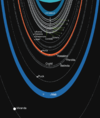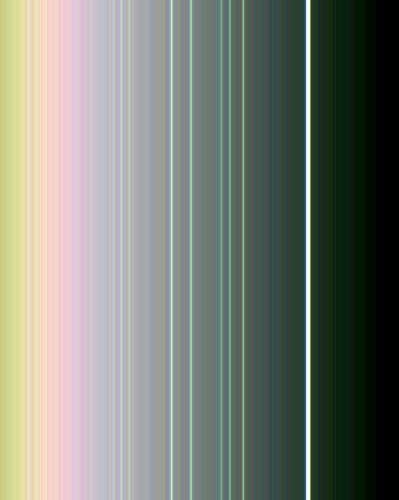Uranus
Uranus (Latinization from ancient Greek οὐρανός uranós, German 'sky') is the seventh planet in the solar system from the Sun, with an average solar distance of 2.9 billion kilometers, and is counted among the ice giants. It was discovered on 13 March 1781 by Wilhelm Herschel and is named after the Greek sky god Uranos. It is thus the only planet named after a god of the Greek world of gods.
The diameter of this giant planet is over 51,000 kilometers, about four times the diameter of the Earth, and its volume is about 65 times that of the Earth. Physically, Uranus is comparable to Neptune and takes fourth place after it in the mass ranking in the solar system among the planets, with about 14 Earth masses. In terms of diameter, it is just ahead of Neptune in third place - after Jupiter and Saturn.
The astronomical symbol of Uranus![]() is similar to the Mars symbol. Unlike the latter, the circle has a central point, and the arrow on the circle is vertical. Another Uranus symbol used mainly in astrology is
is similar to the Mars symbol. Unlike the latter, the circle has a central point, and the arrow on the circle is vertical. Another Uranus symbol used mainly in astrology is ![]() .
.
Uranus is only visible with the unaided eye under very favorable circumstances, but can already be seen well in small binoculars. Its pale green disk is about 3.5″ across when viewed from Earth. As of 2020, Uranus is in the constellation Aries, making it easy to observe in the fall and winter skies. It moves eastward on the ecliptic by a good 4° per year, and in 2024 it will enter the constellation Taurus.
Orbit and rotation
Orbit
Uranus orbits the Sun in an approximately circular orbit with an eccentricity of 0.0457 between Saturn and Neptune. Its closest point to the Sun, perihelion, is 18.324 AU and its farthest point from the Sun, aphelion, is 20.078 AU. At nearly 3 billion km apart, it is about twice the distance from the Sun as the closest planet, Saturn. This orbital radius fits exactly the Titius-Bode series formulated in 1766, so that the discovery of Uranus was regarded as a confirmation of the view of a "world harmony" founded by Kepler at that time.
The orbital plane is inclined only slightly against the Earth's orbital plane at 0.772° and thus has the lowest inclination compared to the other planets. For one orbit around the sun Uranus needs about 84 years. With an average orbital velocity of 6.81 km/s, it takes about two hours to cover its own diameter (the Earth takes about seven minutes).
Rotation
Uranus rotates once around its axis in 17 hours 14 minutes and 24 seconds. As with all giant planets, strong winds blow in the direction of rotation in the high atmosphere. At southern latitudes (about 60°) the visible atmosphere moves much faster and the rotation time there is correspondingly shorter at 14 hours.
As a special feature, the rotation axis of the planet lies approximately in its orbital plane, it "rolls" forward on it, so to speak, when the axis points towards the sun. The inclination of the axis against the orbital plane is 97.77°, so that Uranus rotates retrograde. As a result of this inclination, after each half orbit, once the northern hemisphere and once the southern hemisphere face the Sun. With the exception of a narrow equatorial region, it is then continuously bright or dark on the respective hemispheres for at least one complete revolution (comparable to polar day and polar night on Earth).
When Voyager 2 flew past Uranus on January 24, 1986, the Sun was nearly over its south pole. In 2007, it was briefly in its equatorial plane at the equinox.
The cause of the strong axial inclination is unknown. The most common hypothesis assumes a collision with a large protoplanet during the formation phase. According to computer simulations, Uranus would have to have been hit by two or more celestial bodies or by a protoplanet twice the size of Earth during its formation and the formation of its moon and ring system to explain the inclination of the entire Uranus system to the planet's orbit.
Ring System
→ Main article: Rings of Uranus
Uranus, like all giant planets in the solar system, is surrounded by a host of very small bodies and particles that orbit the planet in the direction of its rotation, forming a system of concentric rings with their orbits of varying density. These are mostly in the equatorial plane of the planet and mainly within the Roche boundary.
The ring system of Uranus was discovered on March 10, 1977 by James L. Elliot, Edward W. Dunham, and Douglas J. Mink using the Kuiper Airborne Observatory. The discovery was a stroke of luck. They planned to observe the occultation of the star SAO 158687 by Uranus to study its atmosphere and diameter. When they analyzed their observations, they found that the star briefly disappeared an additional five times each just before and after the actual occultation. They concluded that there must be a ring system around the planet. The rings were photographed directly by Voyager 2 when the probe passed Uranus in 1986. It was the second ring system discovered in the solar system, after Saturn's.
| Ring | Distance of the inner edge from | Latitude | |
| Center | Equator | ||
| Zeta (1986 U2R) | 38.000 | 12.440 | 3.500 |
| 6 | 41.840 | 16.280 | 1–3 |
| 5 | 42.230 | 16.670 | 2–3 |
| 4 | 42.580 | 17.020 | 2–3 |
| Alpha | 44.720 | 19.160 | 7–12 |
| Beta | 45.670 | 20.110 | 7–12 |
| Eta | 47.190 | 21.630 | 0–2 |
| Gamma | 47.630 | 22.070 | 1–4 |
| Delta | 48.290 | 22.730 | 3–9 |
| Lambda (1986 U1R) | 50.020 | 24.460 | 1–2 |
| Epsilon | 51.140 | 25.580 | 20–96 |
| Ny (R/2003 U 2) | 65.400 | 39.840 | 3.800 |
| My (R/2003 U 1) | 86.000 | 60.440 | 17.000 |
Uranus, like Jupiter, has a very fine and dark ring system. As for the size of the particles, as with Saturn, it consists of both coarse particles and chunks up to 10 meters in diameter, and fine, but proportionately much smaller dust. On average, the particles are larger than those in Saturn's rings, but in total number they are much fewer. Voyager 2 found that the total mass of Uranus' rings is less than the particle mass in the Cassini division of Saturn's rings. As the most striking difference from the formations of the other giant planets, they are mostly narrow, but sharply bounded and separated by large apparent voids. Not all of them are circular or lie in the equatorial plane of Uranus. The brightest of them-the eleventh from Uranus-is designated by the Greek letter epsilon (ε). In its section nearest the planet it is 20 km wide and nearly opaque, but in its section farthest from Uranus it is five times wider at 96 km and five times as transparent. The innermost moons Cordelia and Ophelia, as shepherd moons, hold the dense Epsilon ring together from the inside and outside by their gravitational effects.
The two rings last discovered by the Hubble telescope in December 2005 are located far outside the previously known eleven and are much wider. Because of their great distance from Uranus, they are called the outer ring system. The larger ring lies at twice the distance from the planet as the previously known rings. This makes 13 rings known. In April 2006, images from the Keck Observatory showed the colors of the new rings: one was blue, the other red.
Hubble had also spotted two small moons in 2003, one of which, Mab, shares its orbit with the outermost newly discovered ring. This ring My (μ) shows its highest density at a distance of 97,700 km from the center of Uranus, and its ring particles may have come from the moon Mab.
The inner edge of this ring lies 86,000 km from the planet's center, at the orbit of the moon Puck. A special feature of the ring is a blue glow, which until now was only known from Saturn's E ring. This Saturnian ring apparently consists of very fine ice crystals that reflect sunlight and have their source in geysers on Saturn's moon Enceladus. This supports the assumption that the ice particles of the Uranus ring, which are less than 0.0001 millimetres in size and small enough to scatter blue light, originate from the very icy Uranus moon Mab and were transported into space by meteorite impacts.
The more inner ring Ny (ν) is reddish in colour and probably consists of larger components than the blue ring, as well as smaller ones. Its highest density is at a distance of 67,300 km from the center of Uranus. No moon has yet been discovered in its density maximum. The inner rings of the planet, on the other hand, appear gray.
The rings of Uranus apparently do not lie exactly centrically around the planet, but oscillate somewhat around it. Astronomers suspect that this is due to the gravitational effects of its moons and its oblateness.
The rings of Uranus are probably relatively young. Crevices in their circumference as well as differences in their opacity suggest that they did not form with Uranus. The matter particles in the rings may once have been parts of a moon that was shattered by a high-velocity impact or by tidal forces.

Ring system of Uranus

Image of the Uranus rings taken by Voyager 2 in 1986 (as false color image), on the right the Epsilon ring

Image of the rings of Uranus from Voyager 2
Questions and Answers
Q: What is Uranus made of?
A: Uranus is made of ice, gases and liquid metal.
Q: What gases are found in the atmosphere of Uranus?
A: The atmosphere of Uranus contains hydrogen (1H), helium (2He) and methane.
Q: How hot is the core of Uranus?
A: The small solid core of Uranus is probably about 4,730°C (8,540°F; 5,000K).
Q: How many moons does Uranus have?
A: Uranus has five big moons and many small ones.
Q: Does it have any rings?
A: Yes, it has a small system of 13 planetary rings.
Q: How far away from the Sun is Uranus located?
A: The distance between Uranus and the Sun is about 2.8 billion km.
Q: When was this planet discovered? A:Uranus was discovered in 1781.
Search within the encyclopedia